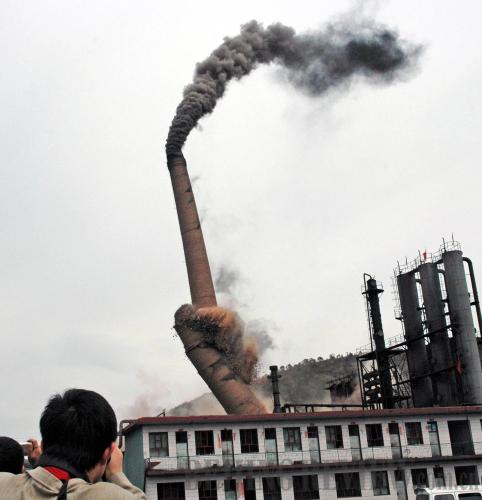|
Tightened regulation
 |
|
EMISSIONS REDUCTION: A chimney in a mechanical coking factory in Puxian County, north China's Shanxi Province, is demolished on March 24, 2007. Strong measures have been taken in China to conserve energy and reduce carbon emissions (XINHUA) |
Frequent crackdowns on polluters have been launched to abate pollution in China.
From the end of 2004 to the beginning of 2005, the then State Environmental Protection Administration, published a list of 30 projects in violation of environmental laws and regulations, ordered them to shut down and severely punished the institutions and persons involved.
The environmental standard has been raised for heavily polluting industries such as coal-fired electricity generation, steel and cement, promulgating a cleaner production standard.
For instance, in 2005, the State Council, China's cabinet, issued the Interim Provisions on Promoting Industrial Restructuring and the Guidance Catalogue for Industrial Restructuring to restrict the expansion of highly polluting industries.
In June 2007, the State Council issued a circular that set up a system to hold local government leaders accountable for missing energy conservation and emissions reduction targets.
To enhance protective measures, the Central Government raised the administrative ranks of environmental protection authorities. In March 2008, the State Environmental Protection Administration was elevated to the Ministry of Environmental Protection, and the status of local environment protection departments was also promoted accordingly.
Local governments also hurried to enact environmental protection regulations. For instance, Hebei Province issued a regulation to reduce pollutants, Henan Province promulgated an ordinance to prevent and control water pollution, and Guizhou Province produced administrative accountability measures regarding the reduction of major pollutants.
Stronger oversight measures have produced results. In June 2011, the National Development and Reform Commission (NDRC) said that China had accomplished its five-year goal for energy conservation and pollution control as energy consumption per unit of the GDP dropped by 19.1 percent during the 11th Five-year Plan period (2006-10), and the emission of sulfur dioxide went down by 14.29 percent, while the chemical oxygen demand was cut by 12.45 percent.
During the five-year period, the government shut down small coal-fired generators with a total capacity of 7.6825 million kilowatts, and eliminated 120 million tons of outdated iron production capacity, 72 million tons of outdated steel production capacity and 370 million tons of outdated cement production capacity. Many polluting paper mills, chemical engineering plants, textile printing and dyeing factories were also closed down.
The energy conservation efforts during the five-year period cut carbon dioxide emissions by 1.46 billion tons, according to the NDRC. Surface-water quality was also improved.
Despite the success, the government has acknowledged that environmental challenges remain daunting and expressed its determination to further conserve energy and reduce emissions.
In July, the State Council released a development plan for energy conservation and environmental protection industries during the period from 2011 to 2015. It spells out incentives for the industries including preferential taxation and land-use policies.
The document predicts that in the 2011-15 period, energy conservation and environmental protection industries will grow at an average annual rate of more than 15 percent, and will have a total output of 4.5 trillion yuan ($714 billion) by 2015, equaling roughly 2 percent of China's GDP.
E-mail us at: wanghairong@bjreview.com | 